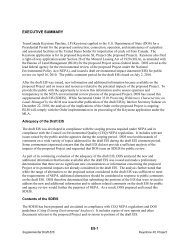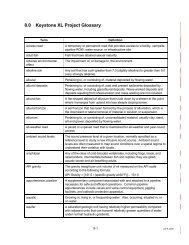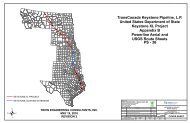2.1 Overview of the Proposed Project - Keystone XL pipeline - US ...
2.1 Overview of the Proposed Project - Keystone XL pipeline - US ...
2.1 Overview of the Proposed Project - Keystone XL pipeline - US ...
Create successful ePaper yourself
Turn your PDF publications into a flip-book with our unique Google optimized e-Paper software.
Draft Supplemental Environmental Impact Statement<strong>Keystone</strong> <strong>XL</strong> <strong>Project</strong>responded to in <strong>the</strong> event <strong>of</strong> a release from <strong>the</strong> proposed <strong>Project</strong> resulting from any cause (e.g.,corrosion, third-party damage, natural hazards, materials defects, hydraulic surge). The planwould address <strong>the</strong> maximum spill scenario and <strong>the</strong> procedures that would be in place to deal with<strong>the</strong> maximum spill. The PSRP requires PHMSA review and approval; however, <strong>the</strong>re is a 2-yeargrace period under which operations can proceed, thus allowing PHMSA time to review <strong>the</strong>document in light <strong>of</strong> as-built <strong>Project</strong> conditions and to require incorporation <strong>of</strong> any neededchanges to ensure system safety prior to PHMSA approval.As required by 49 CFR 195.40, <strong>Keystone</strong> would also prepare and follow a manual <strong>of</strong> writtenprocedures for conducting normal operations and maintenance activities and handling abnormaloperations and emergencies. This manual would be reviewed by PHMSA at intervals notexceeding 15 months, but at least once each calendar year, and appropriate changes would bemade as necessary to ensure that <strong>the</strong> manual is effective. This manual would be prepared beforeinitial operations <strong>of</strong> <strong>the</strong> proposed <strong>Project</strong> and appropriate sections would be kept at locationswhere operations and maintenance activities are conducted. The emergency section <strong>of</strong> thisoperations and maintenance plan would be prepared by <strong>Keystone</strong> in a separate document that<strong>Keystone</strong> refers to as <strong>the</strong> ERP.While <strong>US</strong>EPA has authority under <strong>the</strong> Clean Water Act and Oil Pollution Act <strong>of</strong> 1990 withrespect to regulation <strong>of</strong> onshore non-transportation related facilities and <strong>US</strong>EPA requires <strong>the</strong>development and submittal <strong>of</strong> a Facility Response Plan for any such facility, it appears that none<strong>of</strong> <strong>the</strong> facilities or activities associated with <strong>the</strong> proposed <strong>Project</strong> would be subject to <strong>the</strong> <strong>US</strong>EPAregulatory authority, as discussed below. <strong>Keystone</strong> would <strong>the</strong>refore be required to develop aPSRP for review and approval by PHMSA and an ERP for review by PHMSA for <strong>the</strong> proposed<strong>Project</strong>. PHMSA may request <strong>US</strong>EPA and U.S. Coast Guard consultation on <strong>the</strong> responseelements <strong>of</strong> <strong>the</strong> PSRP. <strong>Keystone</strong> would share on its own volition portions <strong>of</strong> <strong>the</strong> PSRP withcommunity emergency responders along <strong>the</strong> proposed <strong>pipeline</strong> corridor to ensure an appropriatelevel <strong>of</strong> collaborative emergency response planning. However, based on a PHMSA advisorybulletin issued on November 3, 2010, <strong>Keystone</strong> would be required to share <strong>the</strong> ERP with localemergency responders in relevant jurisdictions along <strong>the</strong> proposed <strong>Project</strong> corridor. The bulletinnotes that operators <strong>of</strong> gas and hazardous liquid <strong>pipeline</strong> facilities must make <strong>the</strong>ir <strong>pipeline</strong> ERPsavailable to local emergency response <strong>of</strong>ficials.While <strong>the</strong> draft PSRP and <strong>the</strong> draft ERP for <strong>the</strong> proposed <strong>Project</strong> are not yet available, <strong>Keystone</strong>prepared similar plans for <strong>the</strong> existing <strong>Keystone</strong> Pipeline <strong>Project</strong>. These plans for <strong>the</strong> proposed<strong>Project</strong> would have <strong>the</strong> same general approach as those plans but would have many specificdifferences, such as <strong>the</strong> names and contact information for responders along <strong>the</strong> proposed <strong>Project</strong>route.There have been concerns raised about <strong>the</strong> possibility <strong>of</strong> a spill comparable to <strong>the</strong> Kalamazoospill in Marshall, Michigan, on <strong>the</strong> proposed <strong>Project</strong>. There are a number <strong>of</strong> reasons, discussedbelow, that this is not anticipated. Never<strong>the</strong>less, <strong>Keystone</strong> would be prepared to respond to a spill<strong>of</strong> a similar magnitude and extent <strong>of</strong> <strong>the</strong> Marshall, Michigan, incident. Fur<strong>the</strong>r, <strong>the</strong> lessonslearned from <strong>the</strong> incident would be incorporated into industry recommendations and guidance.<strong>Keystone</strong> would incorporate lessons learned throughout <strong>the</strong> life <strong>of</strong> <strong>the</strong> project in <strong>the</strong> followingways:• PHMSA Advisory Bulletins: These items are incorporated in <strong>the</strong> applicable phase <strong>of</strong> <strong>the</strong><strong>Project</strong> (e.g., design, construction, or operations) through modification <strong>of</strong> <strong>the</strong> <strong>Project</strong>’s<strong>Project</strong> Description <strong>2.1</strong>-69 March 2013











